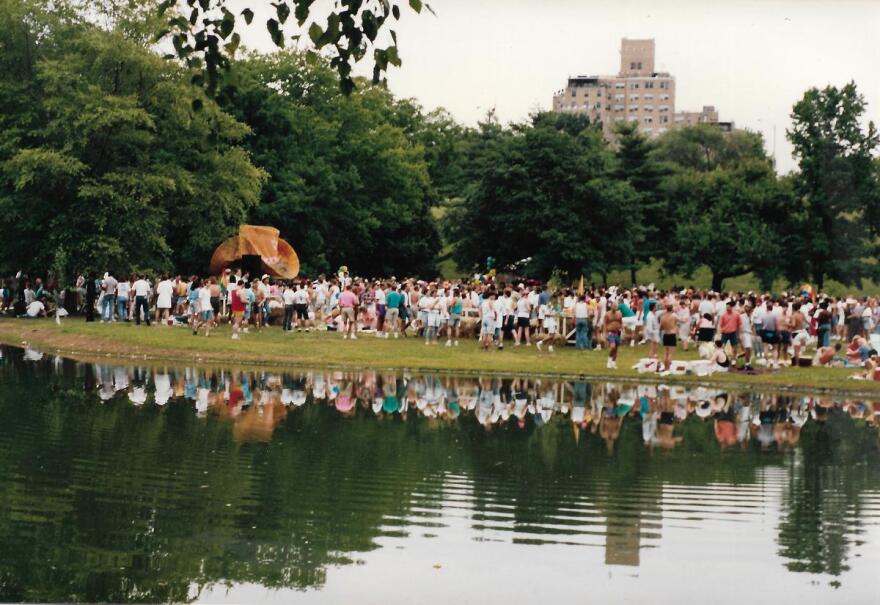When Scott Lokitz was a gay teenager, his mother and grandmother took him to march with dozens of other gay and lesbian St. Louisans down Lindell Boulevard in the city’s first Pride parade.
Marching in a Pride parade was a bold move in 1980, a time when state and national laws forbade consensual same-sex relationships. But Lokitz felt right at home at St. Louis’ first Pride celebration, four decades ago. His mother had come out as lesbian and his grandmother was a member of PFLAG, an organization for those with a gay or lesbian family member.
“It felt natural,” Lokitz said. “It was just a celebration with my family.”
Lokitz continued to march and photograph the annual Pride event, and in the late 1990s became Pride St. Louis’ official photographer.
“They couldn’t get rid of me,” Lokitz said. “I was there photographing it whether I was official or not.”


This weekend, Pride St. Louis celebrates its 40th anniversary with its annual parade and festival near Soldiers Memorial, downtown.
It coincides with the 50th anniversary of the Stonewall rebellion, when gay, lesbian and transgender New Yorkers fought with police who raided a gay bar.
“So I think this year’s celebration will be euphoric and record-breaking all around,” Lokitz, 55, said. “It is so amazing to me that in 50 years, how much progress our community has made, how many strides."
Lokitz's Photos Help Tell the Stories of LGBTQ History

St. Louis PrideFest was held in Forest Park, as seen in this 1992 photo. That same year, HIV became the number-one cause of death for gay men. The next year, President Bill Clinton would sign the "don’t ask, don’t tell" policy banning openly gay Americans from serving in the military. Congress incorporated the policy into law later that year.

In 1996, a handful of TWA employees boldly came out to march in the Pride parade. President Bill Clinton had just signed The Defense of Marriage Act that banned federal recognition of same-sex marriage and defined marriage as a legal union between one man and one woman as husband and wife, which then became law.

Festivalgoers pack Tower Grove Park for the 1999 PrideFest. The festival moved from Forest Park to the south St. Louis park in the late 1990s. In two years, Vermont would become the first state to allow civil unions for same-sex partners.

The Novak’s Bar float, seen here in 2003, was a well-known part of the Pride parade for many years. The mood was high, because just days before the festival, the U.S. Supreme Court handed down its Lawrence v. Texas ruling legalizing consensual same-sex relations.

In this 2009 photo, drag performer Dieta Pepsi stands above the crowd at PrideFest in Tower Grove Park. It would be two more years before "don’t ask, don’t tell" would be repealed, four before the repeal of the Defense of Marriage Act and six more before the U.S. Supreme Court allowed same-sex marriage.

PrideFest moved to downtown St. Louis in 2013. In recent years, more Pridegoers have begun openly identifying as transgender or nonbinary. Until the late 1990s, most Pride groups were known as “gay and lesbian” organizations with some groups also acknowledging people who were bisexual.
In 2019, in Missouri, LGBTQ people can still be fired or denied housing on the basis of their sexual orientation and gender identity.
LGBTQ groups continue to fight against “bathroom laws.” This past January, the U.S. Supreme Court decided to reinstate President Donald Trump’s ban on transgender people serving in the military.
“It’s been an educational experience for me, as a gay man, to learn more about transgender people or gender non-binary folks,” Lokitz said.

This 1982 photo by Wilbur Wegeman shows 17-year-old Scott Lokitz marching in his third Pride parade, fourth in line from the right, wearing white cutoff shorts and striped socks, with his camera around his neck.
If you go:
St. Louis PrideFest
Soldiers Memorial Park, Market Street, N. 15th Street and N. Tucker Street
11 a.m.-7 p.m., Saturday
11 a.m.-6 p.m., Sunday; parade at noon
Free
Follow Nancy on Twitter: @NancyFowlerSTL
Send questions and comments about this story to feedback@stlpublicradio.org







